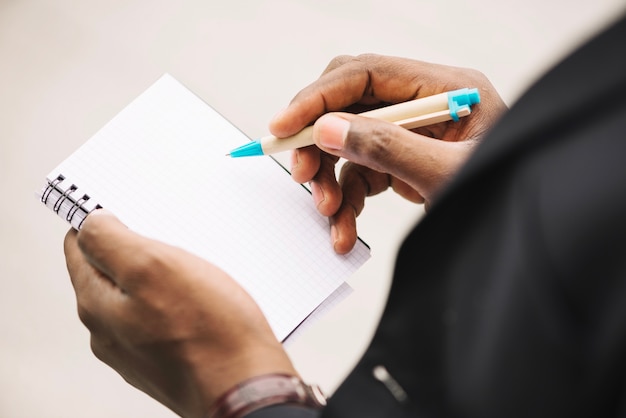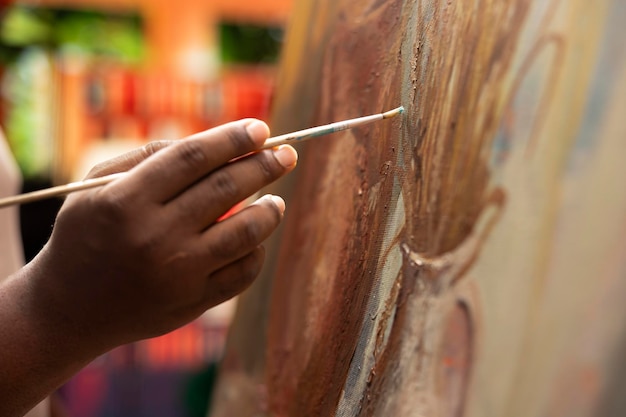That blank page. The empty canvas. That blinking cursor. We’ve all been there. Staring at the void where our brilliant ideas should be, feeling the frustration of creative block tightening its grip.
It’s that nagging feeling that your creative well has run dry, leaving you feeling stuck, uninspired, and questioning your abilities.
Whether you’re a writer, artist, musician, entrepreneur, or someone trying to solve a problem, you will face a creative block sooner rather than later.
But here’s the good news. Creative block is not a sign of failure, lack of talent, or the end of your creative journey. It’s a common, and often temporary, challenge that every creative person faces at some point.
This comprehensive guide will help you understand creative block, explore its common causes, and, most importantly, provide practical strategies for breaking free and experiencing greater creativity.
What Exactly Is Creative Block?

Creative block, sometimes called artistic block, isn’t simply a lack of ideas. It’s a complex psychological state where the flow of creativity is disrupted, making it difficult to generate new ideas, express yourself, or progress on a creative project.
While it might feel like your creative muse has abandoned you, creative block often signals something needs to be addressed. This could be fear, stress, unrealistic expectations, a lack of self-care, or even a need for rest.
It can manifest in many ways:
- Blank Page: The classic inability to start something new, whether it’s a painting, a song, a business plan, or a presentation.
- Perfectionist Paralysis: Feeling like nothing you create is good enough, leading to endless revisions or complete avoidance.
- Idea Drought: Feeling like you’re completely out of inspiration.
- Loss of Motivation: Simply not feeling like creating, even if you have a deadline or a desire to work on a project.
- Overwhelm: Feeling paralyzed by the scope of a project, the number of possibilities, or the sheer volume of work ahead.
Understanding the why behind your block is the first step to overcoming it. We have an article specifically on overcoming writer’s block, but the principles discussed here apply to all forms of creative expression.
Common Causes of Creative Block

I remember last November when I was working on a particularly challenging writing project. I had a clear vision in my head, but every time I sat down to execute it, I froze.
I’d spend hours tweaking minor details, deleting entire sections, and starting over, feeling increasingly frustrated and inadequate. Soon, I was convinced I was out of touch and adjudged myself incapable of producing good work.
It was only after taking a step back and honestly assessing the situation that I realized it was a classic case of creative block, fueled by sheer exhaustion. I was trying to force creativity instead of allowing it to flow.
This realization was the turning point. I took a much-needed break and when I returned to the project, I was able to approach it with fresh eyes and renewed energy.
Beyond stress, let’s look at the most common causes of creative blocks, so you can identify what might be holding you back:
Fear of Failure or judgment
This is perhaps the most pervasive cause. The fear of not measuring up, producing something “bad,” or being criticized can be incredibly paralyzing.
It can lead to self-censorship, procrastination, and avoidance. This fear often stems from a deep-seated need for external validation. Addressing this fear often starts the process of breaking a creative block.
Perfectionism
The relentless pursuit of flawlessness can stifle creativity. Setting impossibly high standards makes it difficult to start, and even harder to finish, anything. The inner critic becomes overly active, stifling the natural flow of ideas and leading to creative blocks.
Lack of Inspiration
Sometimes, you genuinely might feel like you’ve run out of ideas. This can happen when you’re tired, burnt out, or haven’t been actively seeking new experiences and input.
However, what often feels like a lack of inspiration is actually a block to accessing it. Finding ways to overcome creative block in this situation involves actively seeking out new stimuli.
Stress and Burnout
When you’re overwhelmed by stress, your brain’s resources are diverted to managing the stress response, leaving less energy for creative thinking.
Burnout, a state of chronic emotional, physical, and mental exhaustion, can completely extinguish your creative fire. Addressing stress is key to overcoming creative block.
Lack of Structure/Routine
A lack of structure is a very common cause of creative block.
While some people thrive on spontaneity, a complete lack of structure can make staying consistently creative difficult.
Without dedicated time and space for creative work, it’s easy to push it aside.
Unrealistic Expectations
Setting unrealistic goals or timelines for yourself can lead to feelings of overwhelm and discouragement. Expecting to create a masterpiece on your first try is a recipe for disappointment and a sure path to a creative block.
Comparison to Others
In this age of digitalization, it’s easy to fall into the trap of comparing your work to the curated highlights of others. This can lead to feelings of inadequacy and stifle your unique voice, resulting in a frustrating creative block.
Proven Strategies for Overcoming Creative Block

Now for the good news: creative blocks are beatable. Here’s a range of practical strategies you can use to reignite your imagination and get back to creating:
- Change Your Environment: Sometimes, a simple change of scenery can work wonders. Go for a walk, work in a coffee shop or library, or visit a museum or art gallery. Immerse yourself in the creativity of others. You can also organize your space. The key is to expose yourself to new stimuli and break free from your usual routine.
- Try Brain Exercises: Instead of forcing yourself to create something perfect, try some low-pressure brain exercises to get your creative juices flowing. This could be free drawing, sound/music exploration or even just playing with modeling clay. Don’t worry about the outcome. Just focus on the process.
- Mind Mapping: This visual brainstorming technique helps you explore connections between ideas and generate new possibilities. Start with a central topic or question related to where you are experiencing a creative block, and then branch out with related ideas, keywords, and images. It’s a powerful way to get out of a creative block by seeing things from a new perspective.
- Brainstorming (with Variations):
- Classic Brainstorming: Generate as many ideas as possible, without judgment.
- Worst Possible Idea: Intentionally come up with the worst ideas you can think of. This can be surprisingly liberating and often leads to unexpected breakthroughs.
- Reverse Brainstorming: Instead of brainstorming solutions, brainstorm ways to worsen or make the problem worse. This can help you identify the root causes of the creative blocks and find solutions.
- The Two-Minute Rule: If you’re feeling overwhelmed, commit to working on your project for just two minutes. Often, the hardest part is getting started, and this small commitment can help you overcome inertia. Once you’ve started, you’ll likely find it easier to continue, easing you out of the creative block. Check our article on the Two-Minute Rule.
- Embrace Imperfection: Permit yourself to create “bad” art, “rough” drafts, or “imperfect” ideas. The goal is to get something down, not to create a masterpiece on the first try. Remember, you can always edit and refine later. This is a necessary mindset shift for dealing with creative block caused by perfectionism.
- Seek Inspiration from Other Sources: Exposing yourself to new ideas and perspectives can spark your creativity and show you how to get over your creative block.
- Read books, articles, or blog posts related to your field or interests.
- Watch movies, documentaries, or TED Talks.
- Listen to music or podcasts.
- Look at art, photography, or design.
- Engage in conversations with other creatives.
- Collaborate with Others: Working with other creative people can provide fresh perspectives, new ideas, and accountability. Brainstorm together, critique each other’s work, or simply provide mutual support. This can be particularly helpful for breaking through creative blocks in collaborative projects.
- Practice Mindfulness: Mindfulness techniques, such as meditation or deep breathing exercises, can help you reduce stress, quiet your inner critic, and improve your focus. Even a few minutes of daily mindfulness can make a significant difference in managing the anxiety that often accompanies a creative block.
- Take a Break: This is a powerful, yet often overlooked, way to overcome creative block. Sometimes, the best thing you can do is step away from the project completely. Take a nap, go for a walk, do something you enjoy, or simply allow yourself to rest. Giving your mind a break can help you return to your work with renewed energy and perspective, making it easier to see solutions you might have previously missed.
- The “Curiosity Spark Method”: Cultivate a mindset of curiosity by actively seeking out new experiences and observations in your everyday life. Turn mundane moments into potential sources of inspiration (Further explore this in our upcoming resources)
- Set realistic goals: Break down large overwhelming tasks into smaller manageable bits. This is an effective technique for long-lasting and complex creative blocks.
6 Steps to Build A Sustainable Creative Practice

Overcoming creative block is not just about getting past a temporary hurdle. It’s about building a sustainable creative practice that supports your long-term growth.
Here are some key habits to cultivate:
- Schedule Regular Creative Time: Treat your creative time as a non-negotiable appointment. Block it off in your calendar and protect it from distractions.
- Create a Dedicated Workspace: Having a designated space for creative work can help you get into the right mindset and minimize distractions.
- Develop a Pre-Work Ritual: This could be anything that helps you signal to your brain that it’s time to create (e.g., lighting a candle, listening to a specific playlist, doing a short meditation).
- Find an Accountability Partner: Having someone to check in with and share your progress can help you stay motivated and on track.
- Practice Self-Care: Prioritize your physical and mental well-being. Get enough sleep, eat healthy foods, exercise regularly, and manage stress. A healthy mind and body are essential for creativity.
- Cultivate a Growth Mindset: Embrace challenges as opportunities for learning and growth. View mistakes as learning experiences, not as failures. Believe in your ability to improve and develop your creative skills.
Conclusion
Creative block is a common, and often frustrating, experience, but it’s not insurmountable.
By understanding its causes and implementing the strategies outlined in this guide, you can break free from the grip of creative blocks and experience greater creativity.
Found this helpful? Share this article with other creatives who might be struggling with creative blocks! Let’s help each other unlock our creative potential.


